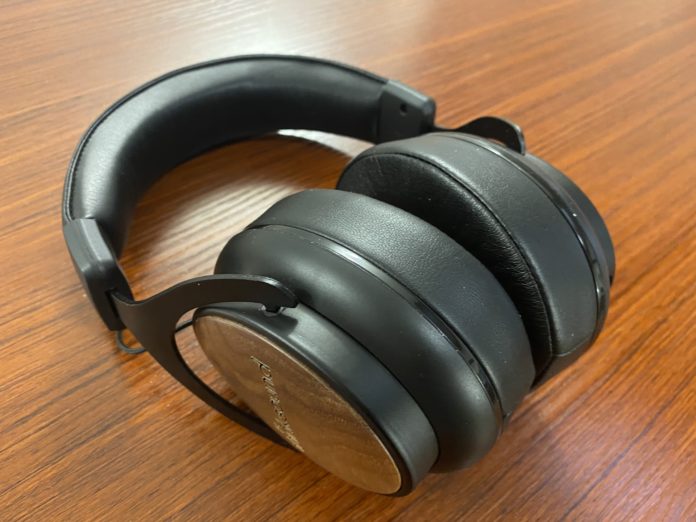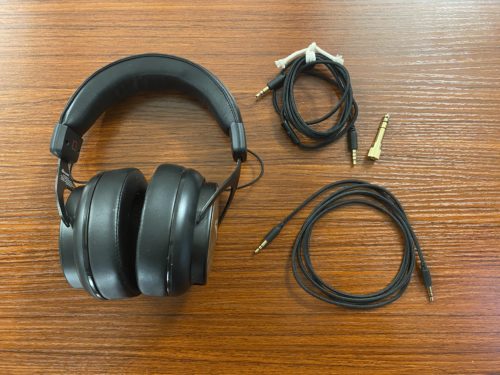It’s always exciting to finally get to try out a new brand of headphones, where you don’t have any expectations of how they might sound. This was my mindset going into the Thinksound OV21, as I have yet to try out any of their headphones previously. The OV21 is a closed-back over-ear headphone designed for professional studio monitoring. A headphone like this doesn’t normally go for $399.99, so let’s see if it makes a good fit.
What You Get
- OV21 Headphones
- Two 3.5mm cables
- One with remote/mic
- Quarter-inch jack
- 2-year warranty
Look and Feel
This is a wooden headphone that takes after the likes of Sivga, featuring a walnut inlay unique to each pair. There are other plastic components used in its build, but the earcup itself is supported by a more solid plastic material as a yoke. This extends up to the headband, which is covered by a thick memory foam pad that considerably reduces the pressure of the headphones. The earcups have the same material too, but the size of the cup is smaller than I would have liked. This style of fit will work perfectly for those who don’t have big ears such as myself, but even then the OV21 still provided me with a suitable level of comfort that made sustained listening sessions far less fatiguing. My ears would still get pretty hot though, but it’s acceptable for the level of isolation you get in return.

Design
Inside of the OV21’s wooden design is a 45mm dynamic driver with a frequency response of 5Hz-22kHz. Not much else can be said about this more streamlined design, but it should be noted that the wooden housing itself does help shape the OV21’s acoustic performance.
Soundstage
Even though the closed-back principle doesn’t extend the soundstage very far, the OV21 still excels in clear spatial positioning and fullness. In terms of width, these headphones won’t blow you away but they still functionally articulate the localization of each sound element well enough to be enjoyable. This creates a focused image where the frequency response still has room to showcase its timbre while maintaining a strong interior headspace. You’ll hear the effectiveness of this soundstage mostly when it comes to the lows, as their aggression calls for giving those elements enough headroom to perform its clarity.
When contemplating its low-end separation, it calls into question the OV21’s utility as a studio monitor, however, the soundstage gives certain frequency accentuations to not feel like they’re becoming distracting to other parts of the sound spectrum. With the OV21 you’re getting a pretty surface-level stereo image, but one that’s given enough height and separation to properly analyze its frequency content. Maybe the soundstage could have used a touch of realism to emphasize its accuracy more, but all-in-all there’s more fun to be had here than listening to the OV21 critically.
Low End
The OV21 is giving you a ton of low-end goodness for what’s supposed to be a studio monitor headphone. When the bass wants to really dive deep into its resonance, the OV21 has no problem delivering a punchy and impactful tone that fills the timbre with a sharp tonality. It takes on a shape that feels incredibly whole, but it will be a pickier reference headphone as it significantly favors its bass. That being said, if you’re not worried about this not being the evenest sound signature, the bass has a lot of meat to satisfy your bass-head needs. There’s a deep vibration in the sub-bass that can really pick you apart, and the mid-bass provides the texture needed to supply the frequency response with a hefty drive that can really shake you.
Mids
It seems like Thinksound wanted the midrange to be where the flatness was considering the neutral timbre it provides. The OV21 never pushes for emphasis in the mids, creating a response that is natural but also a bit dull compared to the lively bass signature. There isn’t much recession or any other dips to note within the timbre, but you don’t get a lot of movement from the frequencies either. The mids really stick to one place, while the rest of the frequency response surrounds it, and sometimes supports it. Vocals take somewhat of a backseat compared to other wooden headphones, and instrumentals are detailed but don’t necessarily pop in this range.
Highs
There’s definitely more to bite on in the treble, as it provides both clarity and somewhat of a sibilant quality to the timbre. You can tell almost immediately that the frequencies have a bit more sharpness to them, giving instruments and effects the right amount of release and finish to their tones. They don’t have much shape as the bass does, but they still provide a nice level of resonance that coats the top-end of the headphone in a crisp layer of rich treble.
Summary
There are a ton of characteristics to the OV21 that I really adore, but I think those expecting a reliable studio monitor might be a bit confused. What I hear when I listen to the OV21 is a headphone with a heavy bass timbre that’s rich and meaty with some crispy highs that provide some great texture to a wide selection of tracks. Even with the more neutral mids, I found the sound to be a bit too colorful to be considered a reference, but it also depends on what genres of music you want to reference in the end. Otherwise, the OV21 is a fun sound that is hard to get tired of.
| Pros | Cons |
|
|
The Thinksound OV21 is available at Audio46.
MAJORHIFI may receive commissions from retail offers.











